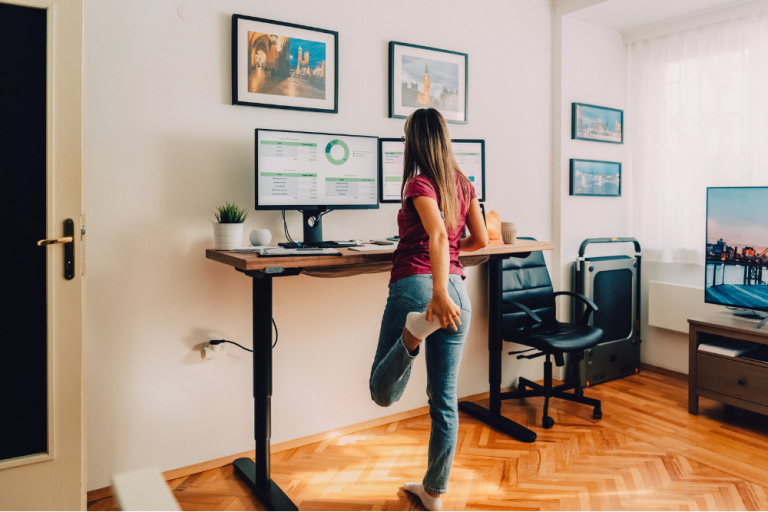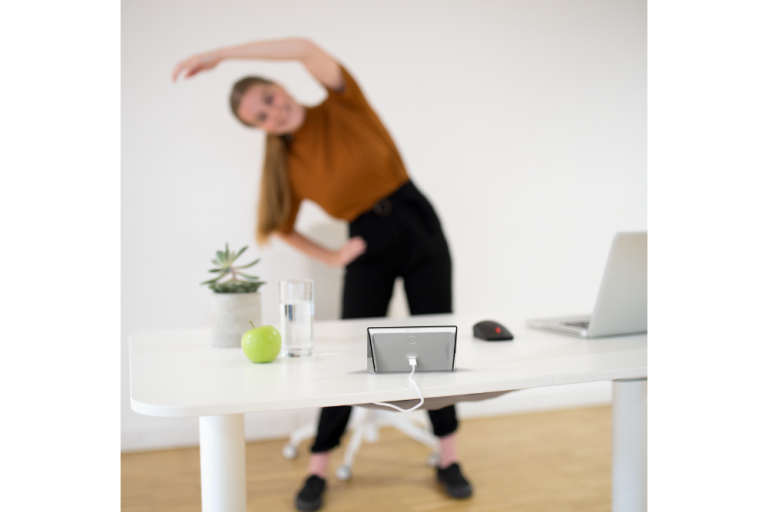
In today's working world, many of us spend the majority of the day sitting in front of a computer. However, this sedentary lifestyle can entail considerable health risks. Sitting for too long and being inactive is a risk factor for various ailments and diseases. A new Study According to a study by the Karlsruhe Institute of Technology (KIT), the risk is even higher when working from home than in the office. In the following, we explain why it is so important to get enough exercise at work, what risks arise from a lack of exercise and how you can ensure more exercise in the workplace.

Too little movement in the workplace can entail considerable health risks. Sitting for too long and a lack of physical activity are closely linked to various health problems. Below are four of the most common risks caused by a lack of physical activity.
Lack of exercise leads to reduced cardiovascular fitness and increases the risk of cardiovascular diseases such as heart attack and stroke. A study by the American Heart Association shows that sitting for too long is significantly associated with an increased risk of cardiovascular disease. Source: American Heart Association.
Source: Sitting Time and All-Cause Mortality Risk in 222 497 Australian Adults
Prolonged sitting and lack of exercise can lead to a negative energy balance and thus to weight gain and obesity or diabetes. A study in the "Journal of Physical Activity and Health" found that people who sit a lot have a higher risk of obesity.
Chronic lack of exercise can lead to musculoskeletal disorders such as back pain, osteoarthritis, neck tension and joint problems. Research in the "Journal of Occupational Health Psychology" shows that prolonged sitting is associated with increased muscular complaints and back pain.
Prolonged sitting and lack of exercise can also have negative effects on mental health, including a higher risk of depression and anxiety. According to a study published in the Journal of Epidemiology and Community Health, lack of exercise may be associated with poorer mental health and a higher risk of depression.
Source: British Journal of Sports Medicine. Sedentary Behaviour and the Risk of Depression: A Meta-analysis

Exercise in the office helps to strengthen the muscles. People who sit a lot should make sure they activate their muscles several times a day to prevent muscle loss. Strong muscles support a healthy posture and help you to cope better with the stresses and strains of everyday life.
Sitting for long periods of time often leads to tension, particularly in the neck and shoulder area. This tension can lead to back pain and limited mobility. Regular movement and stretching exercises can relieve such tension and have a positive effect on posture.
Back and neck pain are widespread complaints among people with an office job and a lack of exercise. One reason for this is the one-sided strain caused by sitting for long periods of time. You can do something good for your back with various techniques, such as dynamic sitting!
One-sided strain caused by repetitive movements or prolonged sitting can lead to poor posture and muscular imbalances in the long term. To avoid this, it is important to change your sitting position several times an hour and integrate different movements into your working day. For example, stand up every 30 minutes, stretch and take a few steps.
Sitting for long periods is not only bad for the muscles and musculoskeletal system, but also increases the risk of cardiovascular disease. Regular exercise promotes blood circulation and supports the cardiovascular system. Even short bursts of exercise, such as a short walk during your lunch break or taking the stairs instead of the lift, can help to reduce the risk.
Regular exercise is important to keep both the body and the mind fit. Exercise activates the muscles, promotes blood circulation and ensures that more oxygen reaches the brain. This in turn increases concentration and mental performance. If you move more often, you will feel more alert, more attentive and better able to concentrate on your tasks. Exercise can also help to reduce stress and improve your general well-being, for example by reducing excess weight and making sport more of a priority.
Sitting for long periods slows down the circulation and can lead to reduced blood flow. This in turn can lead to various health problems such as varicose veins, thrombosis and an increased risk of cardiovascular disease. Regular exercise gets your circulation going and improves blood circulation. Even short, crisp bursts of exercise where you get up and move around can make a big difference and help to boost your metabolism.
Integrating more movement into everyday office life doesn't have to be complicated. Often it is the small changes, that make a big difference. Here are some simple and practical tips to increase your daily activity in the office:
A frequent change of posture helps to relieve the muscles and promote blood circulation. To do this, use an exercise ball or an ergonomic chair to sit dynamically and change your sitting position occasionally. Always make sure you have a good sitting posture to keep your spine healthy and avoid sitting too statically.
Standing desks or height-adjustable desks allow you to spend parts of your working day standing up. This reduces the strain of prolonged sitting and promotes better posture. Even if you have an ergonomic office chair, you should still occasionally work standing up.

Phone calls are an ideal opportunity to get up and move around a bit. Walk around the room during the call or do a few stretching exercises. This is an easy way to get more movement in the workplace.
Get into the habit of doing short movement exercises every 30 minutes. Circle your shoulders, head and neck to relieve tension, improve circulation and do something good for your body.
Plan fixed exercise breaks into your working day. Set reminders on your mobile phone or computer to make sure you don't forget to take these breaks. You can also use digital helpers such as the Isa Health Coach use. Just 3-5 minutes of exercise can help to increase concentration and prevent tension.
Organise your workstation so that you have to get up from time to time. Place frequently used items, such as printers or files, further away so that you can move around from time to time.
Take every opportunity to get up. Go to the printer, get a glass of water or speak to a colleague in person instead of writing an email. Your intervertebral discs and your back will thank you for it.
Stand-up meetings are not only shorter and more efficient, they also encourage movement. Suggest to your team to hold meetings standing up to increase concentration and reduce sitting time.
Many creative tasks can be done while standing or walking. Use the whiteboard or pinboards to visualise ideas while moving around.
Work more often with analogue tools such as whiteboards or post-its. This not only encourages creativity, but also forces you to get up and move around.
Arrange to meet up with colleagues for a short walk in the fresh air. This not only promotes exercise, but also social interaction and team spirit. It doesn't always have to be an intensive sports session. Walks can also keep you fit!
Park your car a little further away or get off public transport one stop earlier to incorporate extra exercise. If possible, cycle directly to work.
Shared movement rituals promote a sense of community and motivation. Do stretching exercises or other short movement units together at the end of a meeting. Motivate and encourage each other to move more.
Keep a Theraband or small dumbbells handy under your desk. Use these to do simple strengthening exercises in between. Here too, short 3-5 minute routines are completely sufficient.
Plan active team events or team-building measures that include exercise. Whether it's hiking together, a sports tournament or a fitness workshop - such activities promote health and team cohesion.

ISA is the smart solution for more movement in the office and a healthy, balanced working day. With ISA, you can increase your well-being through AI-supported health coaching that intuitively integrates healthy routines and dynamic sitting into your daily work routine. Fit in the office made easy with ISA!
By integrating these tips and exercises into your daily work routine, you will not only improve your health and well-being, but also your productivity and satisfaction at work. Remember: every step counts and even small changes can have a big impact! The good news is: it doesn't have to be complicated or stressful! Our valuable tips will help you stay fit at work.